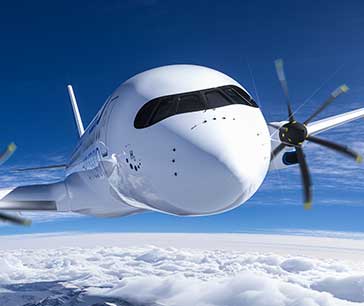Pivotal Trends Shaping the Aerospace & Defense Industry in Q1 2024

In recent years, the Aerospace and Defense (A&D) industry has undergone a transformative evolution driven by key trends that are reshaping its landscape. From groundbreaking technological advancements to a heightened focus on sustainability, the industry is experiencing unprecedented shifts. Allied Market Research has meticulously identified and presented the pivotal trends shaping the A&D industry in the first quarter of 2024.
The Dominance of Advanced Aircraft Technologies
In the aerospace & defense sector, the surge of advanced aircraft technologies stands out as a transformative trend, fundamentally reshaping the industry. One notable development is the rise of autonomous aircraft, leveraging state-of-the-art technologies such as artificial intelligence and advanced sensors to enable unmanned vehicles across diverse applications, including military operations, deliveries, agriculture, and more. The global autonomous aircraft market is on a trajectory of swift expansion, with projections indicating a substantial growth to $37.06 billion by 2031. Another noteworthy trend is aircraft electrification, a paradigm shift aiming to power aircraft systems through electrical means. This strategic shift enhances fuel efficiency and contributes to reducing emissions and extending aircraft range. The global aircraft electrification market is expected to reach $21.8 billion by 2032, driven by the industry's commitment to sustainable and cost-effective air travel.
In addition, the aircraft electrical system, functioning as the nerve center for electrical power distribution throughout the aircraft structure, is another pivotal trend in this industry. Propelled by heightened air travel demand and advancements in electric and hybrid aircraft, the global aircraft electrical system market is positioned to grow from $16.9 billion in 2022 to $30.7 billion by 2032. Furthermore, the emergence of more electric aircraft technology signals a substantial shift towards the partial or complete electrification of aircraft functions. This innovative approach not only addresses environmental challenges linked to traditional jet-fuel-based aircraft but also leads to tangible benefits such as reduced aircraft mass, lower fuel consumption, and minimized emissions. Collectively, these advanced technologies underscore the aerospace and defense sector's unwavering commitment to innovation, sustainability, and elevated operational efficiency.
The Rise of Cybersecurity in Defense Systems
As defense systems become increasingly digitized, the focus on cybersecurity has intensified to safeguard critical military infrastructure and data from evolving cyber threats. Cybersecurity measures are crucial for protecting assets against cybercrime, terrorism, and network disruptions that could impact daily operations. This involves actively monitoring IT assets, identifying outages or malicious activities, and responding promptly to disruptions. The defense industry is transitioning into the digital realm, with growing data generation, storage, and transmission. Cybersecurity solutions play a pivotal role in enabling defense organizations to monitor, detect, report, and counter internet-based cyber threats, including attempts to damage or disrupt information systems through spyware, malware, and phishing.

The global defense cybersecurity market is witnessing significant growth and is anticipated to reach $43.4 billion by 2031 at a CAGR of 7.7%. Moreover, aerospace cybersecurity is essential in maintaining industry standards for securing critical information flow to and from aircraft. As the aerospace sector advances in technology, robust cybersecurity practices are imperative. The global aerospace cybersecurity market is anticipated to reach $92.0 billion by 2031, growing at a CAGR of 9.0% from 2022 to 2031. In the digital age, cybersecurity is a paramount concern, and proactive measures are crucial to ensuring the integrity and security of defense and aerospace operations.
Growing Space Exploration Initiatives
A surge in collaborative space exploration efforts between governments and private entities is evident, with ambitious missions such as lunar exploration, Mars expeditions, and advanced satellite deployment. The space propulsion system's crucial role in propelling spacecraft and satellites is important to these missions. The space propulsion system market is growing significantly, driven by increased demand for low earth orbit (LEO) services, a rise in space exploration missions, and growing reliance on satellite data. The global space propulsion system market is anticipated to reach $32.8 billion by 2031, with a CAGR of 14.3%.

Concurrently, the spacecraft market is expanding due to increased investments in space exploration, the development of reusable spacecraft technology, and a surge in exploration missions. The global spacecraft market is expected to reach $10.4 billion by 2032, growing at a CAGR of 5.9%. On the other hand, interplanetary exploration missions and advancements in space rovers, equipped with technologies like lightweight robotic arms, are driving the spacecraft and space rovers markets.

The global space rovers market is anticipated to reach $998.29 million by 2030, growing at a CAGR of 9.2%. Ongoing missions by space agencies and collaborations for innovative technologies, such as Maxar Technologies' Space Infrastructure Dexterous Robot (SPIDER), indicate a promising future for space exploration capabilities. The collective momentum in space exploration initiatives positions the industry for substantial growth and advancements in the coming years.
Growing Significance for Sustainable Aviation Practices
Sustainable aviation practices are gaining prominence in the aerospace and defense sector, with companies actively embracing eco-friendly technologies to reduce their carbon footprint and align with global climate change initiatives. A notable trend is the growth of the hybrid aircraft market, where companies are developing aircraft with hybrid-powered systems, combining electric and fuel-based propulsion for enhanced efficiency and reduced environmental impact. Despite challenges like high development costs, the market is thriving due to factors such as improved fuel efficiency and increased investments.
The global hybrid aircraft market is anticipated to reach $10.2 billion by 2035, with a CAGR of 18.2% from 2025 to 2035. Simultaneously, the electric aircraft market is surging, driven by environmental concerns and technological advancements. Valued at $8.5 billion in 2021, it is expected to reach $23.5 billion by 2031, growing at a CAGR of 10.9% from 2022 to 2031. Ongoing advancements are addressing challenges like large batteries and limited infrastructure capabilities. Major companies worldwide, exemplified by initiatives like Collins Aerospace's expansion plans, are investing in research and development to bolster electric aircraft capabilities. In essence, sustainable aviation practices are reshaping the aerospace and defense sector, ushering in a new era of environmentally conscious aviation.
Rise in Global Defense Alliances
The aerospace & defense sector is witnessing a pivotal trend with a rapid surge in global defense alliances, driven by the evolving geopolitical landscape. Nations are increasingly recognizing the importance of collaborative efforts to address shared security challenges, resulting in the formation of strategic partnerships. These alliances not only foster joint development programs but also facilitate crucial information sharing among participating nations. Within this context, Defense Logistics (DL) plays a vital role, encompassing the supply of necessary resources for the defense industry across diverse operational scenarios. Efficient logistics is instrumental in enabling continuous military deployment and responding effectively to unforeseen challenges by facilitating the seamless movement of equipment, ammunition, vehicles, and other resources.
Proficiency in defense logistics directly correlates with a nation's military strength, offering strategic flexibility and the potential to secure a decisive position of advantage. Factors such as increased government defense expenditure, military modernization programs, geopolitical tensions, and the need for resilient military supply chains are propelling the growth of the defense logistics market. Despite challenges like insufficient infrastructure and cybersecurity threats, the market is poised for expansion, driven by a growing focus on sustainability, environmentally friendly practices, and technological advancements. The global defense logistics market, valued at $203.8 billion in 2022, is anticipated to reach $329.9 billion by 2032, reflecting a robust CAGR of 5.0% from 2023 to 2032.
The Bottom Line
These key trends in the aerospace & defense industry in the 4th quarter of 2023 offer a comprehensive view of the sector's trajectory. As the industry evolves, embracing these trends becomes imperative for stakeholders seeking to navigate the changing landscape. For in-depth insights and strategic guidance on these transformative developments, contact AMR analysts today.



